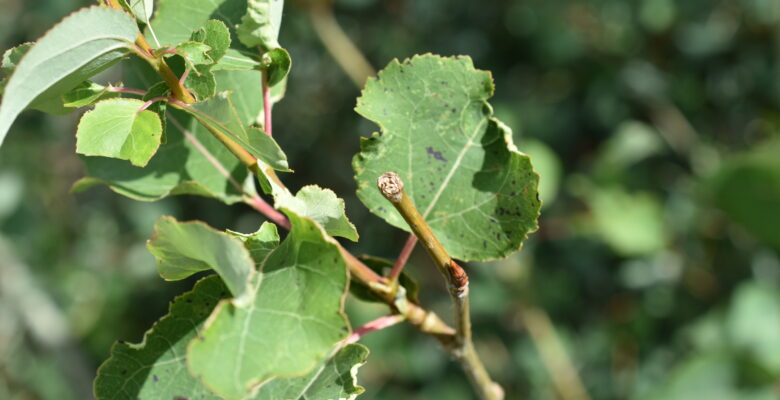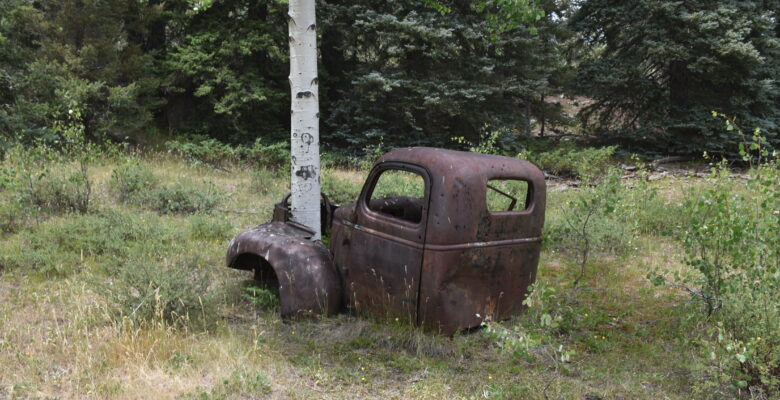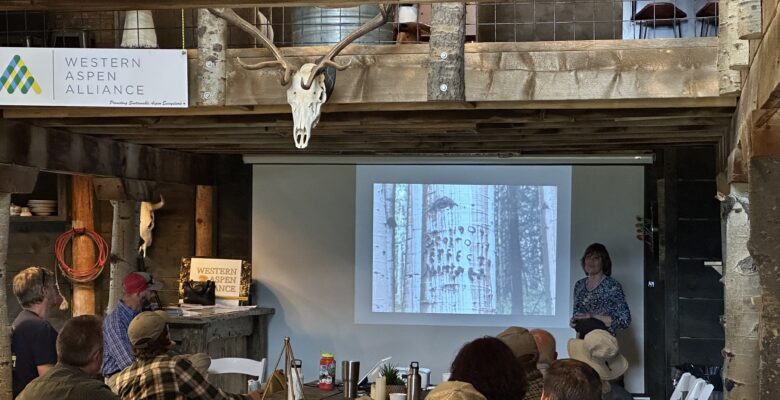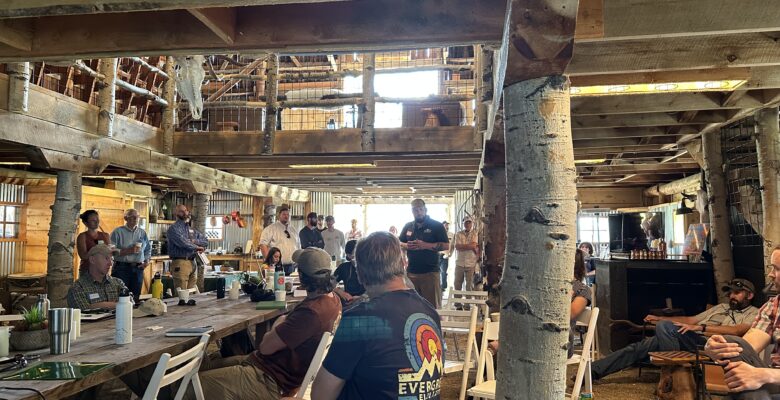
- This event has passed.
Colorado Aspen Summit 2023
July 31, 2023 - August 3, 2023
Summary of Event and Photos
 Field visit to aspen stand in San Juan National Forest. Photo credit: Brooke Simmons
Field visit to aspen stand in San Juan National Forest. Photo credit: Brooke Simmons
Summary
The 2023 Colorado Aspen Summit was held July 31-August 2, 2023, south of Pagosa Springs, Colorado. Considering increasing disturbances from fire, as well as insects and pathogens, heavy herbivory leading to widespread declines in recruitment, as well as the expected reintroduction of wolves, the role of natural resource managers – foresters, wildlife biologists, scientists, and land managers – has never been more important for aspen. The three-day workshop examined four emerging trends to which managers will likely have to adjust stewardship actions to appropriately sustain aspen forests into the future.
Attendees gathering in the meeting barn at Sombrilla Springs. Photo credit: Paul Rogers
Emerging trends:
An invasive sapsucking insect, oystershell scale, which causes aspen mortality at low-elevations and in exclosures designed to protect aspen from herbivory, has recently become widespread throughout Arizona, and has been spotted in northern Utah. It is likely expanding across the West. It causes damage leading to aspen mortality. While it has not been found in native aspen stands in Colorado, it is a rapidly-spreading insect advancing from urban apple orchards into the wildlands and we expect it will be found in Colorado in the future. It is important to work collectively to identify it and coordinate a regional approach.
Herbivory from deer, elk and moose has led to widespread declines in aspen recruitment across portions of its range. Herbivory often affects private and public lands differently, frequently dependent on hunting pressures. Ungulate movement due to hunting pressures can often create a disproportionate impact on the vegetation. For example, in areas with hunting, browse pressure is often lower as animals move through the landscape than in areas without hunting. On private land, managers have experimented with the creation of barriers, such as fencing, to prevent entry with varied success. Across all lands, engaging with wildlife biologists and state agencies about carrying capacity decisions and impact on aspen is important.
Wildfire, bark beetle outbreaks, drought, flooding and a general warming trend are having greater impacts in Colorado’s forests. While these repeated disturbances are natural to the system, they are occurring with increased frequency in space and time. Generally, aspen seems to respond well to short-term reoccurrence of disturbance events; it can reproduce and persist in such conditions where conifer species, dependent on growth from seed, are much slower to recover. However, managers are now encountering novel forest trajectories. Monitoring aspen recovery in post-disturbance landscapes will be important to informing future stewardship actions.
And finally, one we did not discuss in depth at the summit, but we should keep an eye on, is wolf reintroduction in Colorado, which may have an eco-system-wide impact. In May 2023, the State of Colorado finalized a plan to reintroduce wolves by the end of the year. Under the plan, Colorado would release 10-15 wolves on state or private land each winter over the next three to five years. In Yellowstone, the reintroduction of wolves had a ripple effect felt throughout the ecosystem, which decreased browse pressure on aspen.
Lastly, monitoring the outcomes on aspen in areas where browse, drought, fire, beetle-kill of conifers, or flooding overlap is sometimes overlooked, but critically important.
 Workshop attendees observe an herbivory fence at Rancho Del Oso Pardo, NM. Photo credit: Paul Rogers
Workshop attendees observe an herbivory fence at Rancho Del Oso Pardo, NM. Photo credit: Paul Rogers
 Tent site amongst the aspen stand at Sombrilla Springs. Photo credit: Paul Rogers
Tent site amongst the aspen stand at Sombrilla Springs. Photo credit: Paul Rogers
Overview of the workshop
Land managers, wildlife biologists, foresters, aspen experts, as well as those new to the field, gathered at Sombrilla Springs on the Reed Hare Ranch near Pagosa Springs, Colorado, from July 31st to August 2nd for the 2023 Colorado Aspen Summit. Organizers designed this three-day, field-based workshop to enhance participants’ understanding of emerging aspen management issues. Paul Rogers from the Western Aspen Alliance, alongside a team of regional experts, facilitated the event.
The summit included an afternoon of presentations followed by two days of field sessions where the group engaged with local landowners. This interaction provided insights into the challenges of aspen management in southern Colorado and offered a platform to exchange strategies. Participants had the opportunity to visit both private lands and federally managed forests, allowing them to witness firsthand the range of management actions possible and to learn from diverse approaches.
 Sombrilla Springs barn on the Reed Hare Ranch. Photo credit: Brooke Simmons
Sombrilla Springs barn on the Reed Hare Ranch. Photo credit: Brooke Simmons
Background
The Western Aspen Alliance at Utah State University is dedicated to advancing research, restoration and conservation efforts focused on quaking aspen trees throughout the western United States. The organization annually coordinates field-based learning workshops across several Western states designed to provide a forum for interaction between agencies and disciplines. In 2022, the Western Aspen Alliance and partners hosted a workshop near Granby, and in 2023, a workshop south of Pagosa Springs. At the core of this approach is the belief that aspen conservation depends on knowledge sharing across ecological and administrative boundaries.
Aspen is a widespread tree species in North America and occurs across a broad range of elevations in Colorado. Covering five million acres – nearly 20% of the state’s forested land – Colorado is the state with the highest percentage of aspen forest in any of the lower 48 states. In Colorado, aspen generates millions in tourist revenue, is one of the most species-diverse and carbon-rich forest types, and is an important habitat for plants, insects, and mammals such as moose, elk and deer. In addition, aspen serves as a source of fiber and wood in southern Colorado.
Across the West, managers and scientists have observed aspen decline at the edges of its distribution. A continued warming climate may further influence the location and extent of aspen forest on the landscape. For example, initial research suggests that post-disturbance, aspen will be retained on the landscape, but will potentially shift to higher elevations. Given these expected changes, monitoring is important to understand how aspen ecosystems are responding to changes to inform management decisions.
Aspen are highly susceptible to disturbance, but frequently regenerate from a clonal root or grow from seed. These forests, characterized by their thin bark, are susceptible to insect pests and pathogens, herbivory and injury from browse, as well as drought and heat-related mortality. Efforts to integrate monitoring and management will enable us to explore novel conditions, as well as adjust stewardship actions to appropriately sustain these valuable forests into the future.
 Herbivory impacts on an aspen tree. Photo credit: Paul Rogers
Herbivory impacts on an aspen tree. Photo credit: Paul Rogers
Presentations
Opening Plenary:
-
- Quaking Aspen: Can We Manage to Monitor?, Paul Rogers, Utah State University
- The Future of Aspen in Colorado, Sarah Hart, Assistant Professor, Department of Forest and Rangeland Stewardship, Colorado State University
- Monitoring of Long-Term Trends in Aspen Health, Bradley Lalande, US Forest Service at Gunnison Service Center
Emerging Management Issues & Local Case Studies:
-
- Emerging Diseases and Aspen, Kristen Waring, Northern Arizona University
- Aspen and Wildlife on the Jicarilla Apache Nation, Kyle Tator, Wildlife Biologist, Jicarilla Apache Nation
- Cross-Boundary Aspen Management: Southern San Juan Mountains, Dana Guinn, Forest Stewards Guild, Matt Tuten, State and Private Forestry at the US Forest Service Region 2
 Screenshot from Sarah Hart’s presentation
Screenshot from Sarah Hart’s presentation
Key themes discussed
- Oystershell scale (OSS), an invasive sapsucking insect, has recently become widespread in native aspen stands throughout Arizona and has been spotted in northern Utah. It causes damage leading to aspen mortality in lower elevation stands and within ungulate exclosures created to protect aspen from herbivory. While it has not yet been found in native aspen stands in Colorado, it is a rapidly spreading invasive insect moving from urban apple orchards into the wildlands and is expected to be found in Colorado. Participants agreed to search for OSS during field work. One way to register observations is through the Survey123 app (accessed below).
- Learn more here OSS in this Western Aspen Alliance brief: https://www.fs.usda.gov/Internet/FSE_DOCUMENTS/fseprd1044682.pdf
- Report OSS in Colorado using the app, Survey 123, which you can download on your phone or other mobile device. Scan this QR code from inside the app to load the survey. You do not need an ESRI license to load the app. It is free to all users.
 Heavily infested aspen tree with oystershell scales (with closeup of the scales).
Heavily infested aspen tree with oystershell scales (with closeup of the scales).
Photo credit:
2. Herbivory from moose, elk and deer has led to widespread declines in aspen recruitment across portions of its range. The definition of recruitment differs from that of regeneration, in that recruitment refers to aspen that are greater than 2 meters in height (although definitions vary). Colorado is the state with the highest elk population in the U.S., 290,000 animals, which is twice as found in #2 Oregon with 130,000 animals. Elk browse preferentially on regenerating aspen. They prefer the apical stem of small aspen, which has better nutritional value, than the lateral branches. As a result of strong browse pressures, we often observe “gallery aspen forests,” areas full of old trees with few recruiting stems. A gallery forest is a system on the verge of collapse.
On private or National Park Service lands where hunting is not allowed, we commonly observe a “refuge effect,” in which ungulates seek protection from hunting by moving onto private lands during hunting season, also known as habitat compression. This movement due to hunting pressures can often create a disproportionate impact on the vegetation. The impacts of herbivory also vary by location within the state; for example, in the San Juan Mountains, herbivory inhibits the regeneration to recruitment phase in aspen.
On private land, managers have experimented with the creation of barriers – brush fences, electric fencing on t-posts, hinging aspen trees at 8 feet high followed by the application of barbed wire fencing to prevent entry, fenced exclosures, and even the distribution of mountain lion urine, to deter or physically prevent browse. At Rancho del Oso Pardo, brush fences to be the most efficient deterrent, although they did not work in all instances. However, managers also report that these measures have had varying impacts on aspen, since secondary variables such as aspect and timing of the installation of browse protection measures also affect the ability of aspen to recover. Some managers mused that fencing buys time, but the worry is that it is creating an “aspen ”, essentially a small patch of protected aspen within a large landscape devoid of aspen.
Great Sand Dunes National Park hosts a population of 3,000-4,000 elk, mostly non-migratory. To protect the habitat, the park uses lethal removal of elk, rather than fencing or other physical barriers.
A persistent idea underlying one strategy to control herbivory, often referred to as “swamping herbivory” is that if the area of disturbance (cutting, fire, or other disturbance) is large enough, the resulting size will distribute and diminish the impact of browse throughout the area. Although this idea persists, there remains insufficient empirical evidence to suggest that larger disturbances diminish browse pressure. Instead, there is an opportunity to better understand the dynamics of animal movements and resource use, and the size of disturbance.
For some land managers, the loss of aspen is a “dilution of wildness,” as shared by Kyle Tator of the Jicarilla Apache Nation. Addressing herbivory will be important across all types of land, or else we may face a collective dilution of wildness.
 Photo through binoculars looking at an herbivory control fence. Aspen trees are behind the exclosure fence line. Photo credit: Paul Rogers
Photo through binoculars looking at an herbivory control fence. Aspen trees are behind the exclosure fence line. Photo credit: Paul Rogers
3. Repeat disturbances with a shortened periodicity
Wildfire, bark beetle outbreaks, drought, flooding and a general warming trend are occurring more frequently in Colorado’s forests. While these processes are natural to the system, they are occurring with increased frequency in space and time. Generally, aspen seems to respond well to the short-term reoccurrence of disturbance events; it can reproduce and persist in such conditions where conifer species, dependent on growth from seed, are much slower to recover. However, managers are now encountering novel forest trajectories. For example, post-fire aspen seems to be expanding upslope in elevation [1].
One disturbance, Sudden Aspen Decline (SAD), first observed in 2004 in southwest Colorado, causes concentrated areas of dieback or mortality. However, recent surveys show that drought-induced mortality was less than 30% and that many clones have since recovered partially or wholly. Bradley Lalande and colleagues with the U.S. Forest Service suggest that sudden aspen decline is not sudden and may not cause irreversible decline. Considering these findings, the team suggests that “sudden aspen decline”, as a term, is misleading and propose a new term: “drought-induced mortality”.
 Workshop attendees at an active aspen logging site. Photo credit: Brooke Simmons
Workshop attendees at an active aspen logging site. Photo credit: Brooke Simmons
4. And finally, a topic we did not discuss in depth, but one we should keep explore, is wolf reintroduction in Colorado. In May 2023, the State of Colorado finalized a plan to reintroduce wolves by the end of the year. Under the plan, Colorado would release 10-15 wolves on state or private land each winter over the next three to five years. Specific locations will not be released to the public, but the first release is expected to occur in Pitkin County, and a second release in the West Elk mountain range.
There are well-documented cases of trophic cascades in Yellowstone following wolf reintroduction. These cascading effects included a decrease in the elk population, the return of aspen, willow and cottonwood as browse pressure diminished, and an increase in the beaver and bison populations (who had more forage), among other changes[2].
More about the Colorado wolf reintroduction plan can be found on Colorado Public Radio, here. The final version of the wolf restoration and management plan is here.
Other references and discussion of wolf and other species influences to the Yellowstone ecosystem can be found here:
 Workshop attendees meet in an aspen fuel break at Reed Hare Ranch. Photo credit: Paul Rogers
Workshop attendees meet in an aspen fuel break at Reed Hare Ranch. Photo credit: Paul Rogers
Next steps for the group
- Oystershell Scale Kristen Waring and her collaborators will create a predictive west-wide map of locations most at risk for OSS based on climate and elevation thresholds. Stay tuned for that in the coming 1-2 years!
- Herbivory The targets for animal populations need our input as ecologists, foresters, and vegetation mangers to inform wildlife biologists about the impact of browse on aspen.
- Repeat disturbances Managers can anticipate the shortened periodicity of disturbance as the climate warms, and work on longer-term planning. Managers should not attach themselves to retaining aspen at a given location, but rather must understand that if we lose aspen in a given location, we will likely find it someplace else. Thus, aspen may shift its location following repeat disturbances, but be retained on the landscape.
- A new understanding of long-term effects of drought on aspen We now know that sudden aspen decline is not actually sudden, and the majority of stands did not decline more than 30%. We should move away from using the term “sudden aspen decline”. Drought-induced mortality may be a more accurate term. As one ecologist noted, “aspen lives and dies, a lot!”
- Adaptive management focused on the development of a menu of local silvicultural techniques It will be increasingly beneficial to explore the type of aspen management techniques taking place within a given landscape, rather than following a textbook prescription. There are areas of high experimentation on private lands, including a coppice cut with reserves that we visited, which are rich for learning. A shared goal for managers across all land ownership types is to create complexity within managed units.
- Monitoring Aspen management should be followed up with some form of monitoring to inform future decision-making.
 Workshop attendees at a management site at Rancho Del Oso Pardo, NM. Photo credit: Paul Rogers
Workshop attendees at a management site at Rancho Del Oso Pardo, NM. Photo credit: Paul Rogers
Turning learning into action
One goal of the Western Aspen Alliance is to translate science into action by hosting workshops, sharing timely briefs on emerging issues, such as OSS, and by receiving a regular newsletter. Sign up for this free newsletter and briefs here.
The questions we heard
What are some talking points about the importance of aspen forests? Are there species that only live in aspen and nowhere else?
- High carbon storage: In terms of aboveground carbon storage, aspen forests in Colorado store more aboveground carbon per acre than all forest types other than spruce-fir. In terms of belowground carbon, the story is more complex. Some studies have shown that soil organic carbon storage is greater under aspen forests than conifer forest (although not all). Perhaps more importantly, scientists also think that soil organic carbon under aspen is more stable (although the mechanism here is still being sorted out). So broadly, increasing aspen is thought to increase the resistance and resilience of soil carbon stocks to climate change.
- Keystone species: Aspen has been considered a “keystone” or “foundational” species due to its high levels of plant, insect, and vertebrate diversity. A keystone species is a species that affects the survival and abundance of many other species in the community where it lives. A foundational species defines and structures certain forest ecosystems through their influences on associated organisms and modulation of ecosystem processes.
- High diversity of birds: Aspen provide excellent bird habitat at local, landscape and regional scales. Many studies have documented greater bird species richness in aspen than surrounding conifer forests [3]. One study in the Black Hills reported the following bird species in pure aspen stands: Swainson’s thrush (Cartharus ustulatus), common yellowthroat (Geothlypis trichas), and mountain bluebird (Sialia currucoides) [3]. Others occurred mostly in pure aspen or aspen with ponderosa pine: northern flicker (Colaptes auratus), flycatchers (Empidonax spp.), MacGillvray’s warbler (Oporornis tolmiei), ovenbird (Seiurus aurocapillus), red-napped sapsucker (Sphrapicus nuchalis), chipping sparrow (Spizella passerina), American robin (Turdus migratorius), and warbling vireo (Vireo gilvus) [3].
- Excellent for water storage and regulation Aspen is beneficial to soil water storage and discharge. In one study, aspen had a 42-83% greater potential water yield for runoff and groundwater recharge than a mixed conifer forest [4].
- High diversity of plants. A study in Rocky Mountain National Park identified 188 vascular plants that occurred only in aspen forest, reporting a combined 264 species identified in aspen and conifer forests[5]. In Beaver Meadows plots, aspen occurred in only 1.2% of the vegetation cover, but harbored 45% of all plants observed[5].
- High diversity of butterflies. This same study in Rocky Mountain National Park recorded 33 butterfly species, eight of which were found only in aspen stands [5].
- Habitat and forage Aspen is a favorite forage for elk, who eat young shoots and strip bark.
Want to learn more about the diversity found in aspen forests? Check out the Western Aspen Alliance brief #7: Biodiversity within aspen forests, and Brief # 3: The Role of Fire in Aspen Ecology and Restoration. A comprehensive WAA list can be found here.
What did you like and what did we miss that we should include at future workshops:
- The Colorado State Forest Service asked participants to let them know what can be done to help facilitate more opportunities like this one.
- The group saw incredible experimentation and learned a lot from management approaches on private lands, where browse pressure is often high. Private landowners are well-suited to innovate, and future workshops should continue to prioritize a visit to private lands.
- Participants suggested visiting an area affected by high-severity wildfire to better understand aspen response postfire.
- Organizers hope that future workshops can better engage experts in aspen insect disease and pathogens.
- Most participants felt that group size of forty was ideal.
 Aspen tree growing through the hood of an old truck at Rancho Del Oso Pardo, NM. Photo credit: Paul Rogers
Aspen tree growing through the hood of an old truck at Rancho Del Oso Pardo, NM. Photo credit: Paul Rogers
Thank you!
Thank you! A big thank-you to Sandlin Niccum, owner of Sombrilla Springs at the Reed Hare Ranch, for hosting our group. Many thanks to each of our speakers who graciously volunteered their time to share their expertise with us, including Paul Rogers, Sarah Hart, Brad Lalande, Kristen Waring, Kyle Tator, Matt Tuten and Dana Guinn, Peggy Bergon, Aaron Jones, Sandlin Niccum, and the timber staff of the San Juan National Forest, including Rita Daniels, Kevin Emde, Adam Tlachac, and Will Weisman. We are grateful to each participant who brought a spirit of curiosity and came to share their knowledge and experience. Lastly, thanks to the organizations who sponsored this event by providing financial support, including the Chama Peak Land Alliance, Colorado State Forest Service, Southern Rockies Fire Science Network, The Nature Conservancy, and in-kind support, including the U.S. Forest Service Region 2 State, Private and Tribal Forestry, and the Forest Stewards Guild.
 Peggy Bergon presenting on arborglyphs. Photo credit: Brooke Simmons
Peggy Bergon presenting on arborglyphs. Photo credit: Brooke Simmons
Works cited:
-
Nigro KM, Rocca ME, Battaglia MA, Coop JD, Redmond MD. Wildfire catalyzes upward range expansion of trembling aspen in southern Rocky Mountain beetle-killed forests. Journal of Biogeography. 2022;49: 201–214. doi:10.1111/jbi.14302
-
Ripple WJ, Beschta RL. Trophic cascades in Yellowstone: The first 15 years after wolf reintroduction. Biological Conservation. 2012;145: 205–213. doi:10.1016/j.biocon.2011.11.005
-
Rumble MA, Flake LD, Mills TR, Brookshire BL. Do Pine Trees in Aspen Stands Increase Bird Diversity? 2001. Report No.: RMRS-P-18.
-
LaMalfa EM, Ryle R. Differential Snowpack Accumulation and Water Dynamics in Aspen and Conifer Communities: Implications for Water Yield and Ecosystem Function. Ecosystems. 2008;11: 569–581.
-
Chong G, Simonson SE, Stohlgren TJ, Kalkhan MA. Biodiversity: Aspen stands have the lead, but will nonnative species take over? Grand Junction, CO: U.S. Department of Agriculture, Forest Service, Rocky Mountain Research Station; 2000. pp. 261–272.

